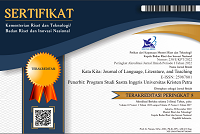Multimodal Analysis on Product Placement in Korean Drama: “Goblin”
DOI:
https://doi.org/10.9744/katakita.8.2.219-225Keywords:
brand awareness, logo, slogan, brand name, promotionsAbstract
Many companies try to find innovative ways of reaching their target market and promoting their products. Product placement (PPL) is one of such innovative ways. PPL has become popular in marketing communication because the promotion in it is quite subtle. It happens because in PPL, the advertisement is integrated in the structure of the narratives of TV series or films where PPL takes place. Thus, PPL can skirt the negative view toward advertising. In this study, we examine how PPL convey advertising messages in Korean drama, Guardian: Great and Lonely God (Goblin). In so doing, by using multimodal theory we analyze the verbal and non-verbal communication practices found some scenes of the Korean drama, and the meaning of PPL semiotic resources in those scenes express. Our findings show that PPL conveys the advertising messages through the acting, the facial expression, and the shot of products.
Keywords: Product Placement, Multimodal, Modes, Goblin, Verbal and Non-Verbal Communication
References
Anstey, M., & Bull, G. (2010). Helping teachers to explore multimodal texts. Curriculum and Leadership Journal: An Electronic Journal for Leaders in Education, 8(16). Retrieved from: http://www.curriculum.edu.au/leader/helping_teachers_to_explore_multimodal_texts,31522.html?%20issue%20ID=12141.
Armenia, R. (2017, April 27). Goblin kalahkan jumlah permintaan descendant of the sun. CNN Indonesia. Retrieved from: www.cnnindonesia.com/hiburan/20170427090942-220-210473/goblin-kalahkan-jumlah-permintaan-descendants-of-the-sun.
Bane, T. (2016). Encyclopedia of beasts and monsters in myth, legend and folklore. Jeffroson, NC: McFarland.
Chan, A. & Chia, C. (2017). Re-defining ‘reading' in the 21st century: accessing multimodal texts. Beyond Word, 5(2), 98-105.
Chae, M. J., & Sun, H. J. (2013). TV product placement in Korea. Journal of Promotion Management, 19(1), 54-75. doi: 10.1080/10496491.2012.736461
Chan, G., H. & Jie, W. (2017). Do Hallyu (Korean wave) exports promote Korea’s consumer goods exports? Emerging Markets Finance and Trade, 53(6), 1388-1404. doi: 10.1080/1540496X. 2017. 1313161.
Doo, R. (2017, January 6). Korean drama ‘Goblin’ popular but controversial. The Jakarta Post. Retrieved from: https://www.thejakartapost.com/life/2017/01/06/korean-drama-goblin-popular-but-controversial.html.
Gangadharbatla, H. & Daugherty, T. (2013). Advertising versus product placements: How consumers assess the value of each. Journal of Current Issues and Research in Advertising, 34(1), 21-38. doi: 10.1080/10641734.2013.754706.
Gdhunter. (2017, March 23). On this day last year, “descendant of the sun” hits 30% viewer ratings. Kdramapal. Retrived from: https://www.kdramapal.com/on-this-day-last-year-descendants-of-the-sun-hits-30-viewer-ratings/.
Gould, S. J., Gupta, P. B. and Grabner-Krauter, S. (2000). Product placements in movies: A cross-cultural analysis of Austrian, French and American consumers’ attitudes toward this emerging international promotional medium. Journal of Advertising, 29(4), 41-58. doi: 10.1080/00913367.2000.10673623.
Hidayati, L. (2017, Oktober 3). Goblin menang besar di korea drama awards 2017. Okezone. Retrieved from https://celebrity.okezone.com/read/2017/10/03/598/1787681/goblin-menang-besar-di-korea-drama-awards-2017.
Hit K-drama boosts sales of South Korean products. (2016, April 2). The Straits Times. Retrieved from: www.straitstimes.com/lifestyle/entertainment/hit-k-drama-boosts-sales-of-south-korean-products.
Kendall, G. (2014, March 4). The science that makes us spend more in supermarkets, and feel good while we do it. The Conversation. Retrived from: https://theconversation.com/the-science-that-makes-us-spend-more-in-supermarkets-and-feel-good-while-we-do-it-23857.
Krippendorff, K. (2004). Content analysis: An introduction to its methodology. 2ed. Thousand Oaks, CA: Sage Publication.
Lehu, J. M. & Bressoud, E. (2007, June 5-8). Viewers and brand placement in movies: New insights about viewers contribute to a better understanding of the effectiveness of the technique. The La Londe Conference in Marketing Communications and Consumer Behavior: International Research Seminar in Marketing. La Londe, France. Retrieved from: https://halshs.archives-ouvertes.fr/halshs-00305723/file/Lehu_Bressoud_2007_Brand_PLacement_viewers_La_Londe
Newell, J., Salmon, C. T., & Chang, S. (2006). The hidden history of product placement. Journal of Broadcasting & Electronic Media, 50(4), 575-594. doi: 10.1207/s15506878jobem5004_1.
Schreier, M. (2012). Qualitative content analysis in practice. Thousand Oaks: Sage Publications.
Spielvogel, I., Naderer, B., & Matthes, J. (2020). Disclosing product placement in audiovisual media services: A practical and scientific perspective on the implementation of disclosures across the European Union. International Journal of Advertising, 1-21. doi: 10.1080/02650487.2020.1781478.
South Korean TV dramas exploit success to push products across Asia (2014, June 23). South China Morning Post. Retrieved from: https://www.scmp.com/business/companies/article/1538513/south-korean-tv-dramas-exploit-success-push-products-across-asia.
D’Souza, J. (2015, May 20). Coffee consumption differs between genders, according to this infographic. Huffington Post Canda. Retrieved
Downloads
Published
Issue
Section
License
Authors who publish with this journal agree to the following terms:- Authors retain copyright and grant the journal right of first publication with the work simultaneously licensed under a Creative Commons Attribution License that allows others to share the work with an acknowledgement of the work's authorship and initial publication in this journal.
- Authors are able to enter into separate, additional contractual arrangements for the non-exclusive distribution of the journal's published version of the work (e.g., post it to an institutional repository or publish it in a book), with an acknowledgement of its initial publication in this journal.
- Authors are permitted and encouraged to post their work online (e.g., in institutional repositories or on their website) prior to and during the submission process, as it can lead to productive exchanges, as well as earlier and greater citation of published work (See The Effect of Open Access).














